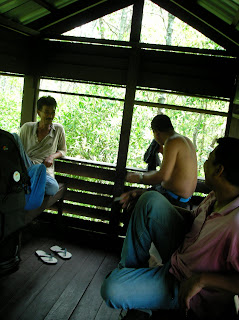Tanjung Piai National Park covers 526 hectares of Mangroves and is the home to many species of mangrove plants and animals. As there are cultivated farmlands in the area, the mangroves have been conserved for the protection of the shoreline from erosions and storms.
Even before we reached the National Park, a Hawk Moth drew our attention and we crowd around it outside a toilet (!!), at a certain petrol kiosk.....
After 4 hours on the road (including 1 hour of stopover for yummy food) , we reached our destination.
Before embarking on the trail, there were already a few back mangrove plants in sight. The Mata Ayam (Ardisia elliptica) is one of them. This plant is named after its fruits because they look like and are about the size of the chicken's eyeball (ayam= chicken, mata = eyes) ! This plant can be recognised by its twigs which are swollen at the base.
The Bakau Minyak (Rhizophora Apiculata) which has red stipules and elliptic leaves was most common at Tanjong Piai. They are easily identified because of their prop roots which increased their stability in the mangrove mud. This species is also able to exclude salt by a filtering system in their roots (by taking in the water, excluding the salt largely). The timber of the Bakau is also made into charcoal, a delight for bbq lovers.
Another common species is Bakau Putih (Bruguiera Cylindrica). Similarly, this species has their own unique way of coping with the harsh environment by having lateral roots growing just below the ground. Some portions stick out of the mud for better absorption of oxygen and looks like the bent knee of a human being.
One distinct feature of Bakau Putih is its sepals of the fruits, which curve backwards towards the fruit stalk.
See the pretty small flowers of Bakau Putih! They are pollinated by day-flying insects such as butterflies.
There is also another species of the Bruguiera spp at Tanjong Piai - Brugruiera Parviflora which ,unlike Bruguiera Cylindrica, have small yellow flowers.
Both Teruntum Merah (Lumnitzera littorea) and Teruntum Puith (Lumnitzera racemosa) can be found at Tanjong Piai, but I only managed to take a picture of Teruntum Puith (my first time seeing this!). A distinct difference between the two is the colour of their flowerse - red for the former, and white for the latter.
Heres a shot of the flowers of Teruntum Putih - pretty, aren't they?
With Christmas round the corner, Tanjong Piai has also started their celebrative atmosphere. A few shrubs of Sea Hollies (Acanthus spp) , named after the unrelated traditional English Christmas plant Holly, were looking really healthy and all "ready for Christmas". The edges of the leaves of this shrub are really sharp as compared to those we see in Sungei Buloh, largely because they are exposed to great amoung of sunlight at the spot they are located.
As the mangrove is home to many species of animals too, we had our fair share of encounters. We saw quite a number of Blue-spotted Mudskippers (Boleophthalmus boddarti) on this trip. Though a fish, it has an amphibious behavior. It is able to stay on land as it retains water in its enlarged gill chambers to keep their gills moist while on land. It can also 'breathe' through its skin too. The 2 big bulging eyes works like periscopes of submarines, allowing it a 360 degree view above water.
The Blue-spotted Mudskipper, unlike other mudskippers which are predatory, grazes on the layer of algae growing on the mud.
These 2 mudskippers were chasing after each other, back and forth, as if in a courtship dance!
As we walk along the boardwalk, we also saw many Long-tailed Macaques (Macaca fascicularis) foraging the mangroves for food. Saw a few of them pounding hard at the mud and digging holes for food, looking hard for crabs, perhaps? This sneaky one climbed up a tree and was eyeing food....
left at the top of an tower, belonging to this group below. These man were stamping the ground, hissing and shouting at the monkeys to chase them away. Is this a case of the monkeys disturbing the human beings? Or really, the other way round instead?
It was a sunny and humid day, probably for the monkeys too. This one was quenching its thirst by drinking human drink - some leftover of Peelfresh orange juice! The carton looked fairly clean and 'new', seems like someone had just littered.... =( With humans feeding them (yes, even if its unintentional), these monkeys might lose their natural ability to search for food (such as crabs etc) meant for them.
The mudcreepers, or more fondly known as chut chut can be commonly seen attached to trunks and roots of mangrove trees. The ones here looked bigger and fatter than the ones some may see in market - yes, they are sold live, and can be fried and eaten with chilli.
Hazel's sharp eyes spotted a baby Malayan Water Monitor Lizard (Veranus Salvator) hanging tightly to a trunk of a mangrove tree.
We also saw countless Mangrove skinks (Emoia atrocostata) there. As they are hardly seen in Singapore, we were all so excited when someone spotted the first one, and spent the longest time waiting for a good photo moment. It was until later into the walk that we realised that they are commonly seen, especially at sunny spots because these cold-blooded creatures relys on the sun to give them body heat.
On a Sea Hibiscus (Talipariti tiliaceum), 2 Cotton Stainer Bugs (Dysdercus decussatus) were mating away, fairly oblivious to our phototaking. They remained and walked around in the same position when they "felt embarrassed" in our presence.
And because of the above act, there are little small red Cotton Stainer Bug nymphs! Many of them were found in the seeds of the Sea Hibiscus, food for the larvae of the bugs. The nymphs' head is black in colour when young, as compared to the red ones of adults.
Looking really similar to the Cotton Stainer Bug, the Thespesia Fire Bug (Dysdercus simon) has a black- coloured head, instead of a red one. This is one endangered bug, and more commonly found on the Portia tree, whose seeds the Thespesia Fire Bug's larvae feeds on. We were initially surprised to find this bug on the Sea Hibiscus, but later realised that it must be because there is a Portia tree beside it.
Dinner was at Kukup. While its not my first time here, the town was not really how I remembered it to be from my recollection, but the food was still as yummy as before.
Before we embark on our journey home, we were all elated to find a new species (of food) - Ang Ku Agar Agar Kuei - after our dinner at Kukup, and bought a few boxes home each! =P
Eveyone must be exhausted after a day of fun as it was all silence on the trip back. So yes - Congratulations! We have been to the southern most tip of mainland Asia!


























1 comment:
How I wish I'm there too! Your posting give me a peek into this fantastic piece of lands ...
Post a Comment